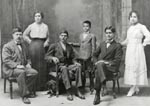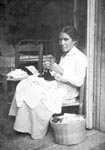Returning to León and Zacatecas
Had the outcome of the country's revolution in 1920 been somewhat different, the following pages would surely show an additional set of magnificient murals from the Santuario de Guadelupe, in the city of Zacatecas. But today, their images are lost forever, eighty-two years after they mysteriously vanished from the altars of the magnificent Sanctuary, now part of the National Museum in Guadalupe.
As far as our records indicate, Candelario received a commission to decorate the Santuario de Guadalupe Church with large murals, paintings, and fresco-like paintings completed on the inside plaster walls.
From the little we know, the commission lasted about one year. It was during this general time period, in June of 1914, that Pancho Villa's División del Norte routed the Federal Army in the well documented Battle of Zacatecas. Over eight thousand federal troops were killed, and all the remaining cities on the way to Mexico City, including Aguascalientes, León and Querétaro were left to the advancing Villistas. As the revolutionary soldiers approached the cities, they entered house after house to take what they wanted. Locked in their house, the Rivas family was terrified as Pancho Villa's soldiers entered their neighborhood.
They all prayed on their knees in front of a painting of the Sacred Heart that Candelario had recently completed. The family records show that the Villistas bypassed the Rivas home that night and left them undisturbed. This was the first of two events that the Rivas family, devout and steadfast in the Catholic faith, would forever attribute to miraculous intervention. The army slowly marched on to Mexico City, arriving there near the end of the year, but before the general did, he sent his men to bring Candelario Rivas to him.
It must have been some time in the fall that Candelario's son, Salvador, recalls coming home at midday to find their house surrounded by soldiers dressed in white, and wearing large sombreros. Villa's soldiers had come to the Rivas household to escort Candelario to the general's residence to paint his new bride's portrait. Herlinda watched as mounted soldiers walked Candelario away, and feared that she would never see him again. She directed one of their servants, an Indian youth, to secretly follow them and to report to her in the morning anything he saw. Then she prayed all through the night.
Late the following morning, the family heard the youth tell that he had caught a glimpse of Candelario through the windows and that he was seen sweeping the floor late in the evening after the sitting. Candelario returned unharmed after several days, with a fee paid in gold coins. But it was not the end of the adventure. Within the week, he was called back to repaint one feature in the portrait: the eyebrows of the general's current wife, who thought they looked unflattering. One of the few remaining facts the family retains of the incident is that Pancho Villa respected Candelario and his work, but that Candelario made it known to him that he disliked painting for the general.
See the painting in the Mexico Gallery.
In August of 1923, after prosperous work in Salamanca, Candelario returned with his family to Zacatecas. However, he was not to stay. Soon after arriving, Candelario met with the church officials who had granted him the commission for the Santuario de Guadalupe Church. They confirmed with him that they were about to leave the country because of their fear of the impending presidency of Plutarco Calles. As governor of the state of Sonora, Calles had ruled with an iron hand, had expelled every single priest from the state, and had confiscated Church property. Those opposed to his dictatorial regime were usually executed. Candelario asked his former patrons what would become of his well-known murals in the Santuario, after the clerics had fled. The rectors told him to do whatever he wanted with the murals in order to protect them from falling into the hands of Calles' officials.
So secretly one night in early September, behind locked doors, and to this day, (until the publishing of this book) unknown to anyone but the Rivas and Gutierrez families of California, Candelario Rivas took a leatherworker's curved knife and cut out the magnificent murals of the Santuario de Guadalupe Church in Zacatecas, Mexico. He rolled up the eight-foot long paintings into a prepared large diameter steel pipe, sealed them with plumber's lead, and buried them in a cemetery where only he knew their exact location. Seeing many of his former patrons going into exile, and fearing for the life of his son José, who had aligned himself with the Catholic Cristero movement (Calles was later to execute over five hundred Cristero leaders), Candelario took his family on the train to El Paso, Texas, and then on to California. There he would live the second part of his life as an artist in the burgeoning city of Los Angeles. And that is where the murals would reappear, fourteen years later, in the City of the Angels.
In Mexico, Candelario's two oldest children were educated at home with tutors. His eldest son, José (Pepe), was taught by Candelario to paint at the early age of four. Before his twentieth birthday, José had already won significant first-place art awards in Zacatecas and León. With a genius that possibly surpassed his father, José, like Candelario, painted professionally for his entire life. Today, the Rivas family retains some of his most impressive works. He is shown here in his studio at about eighteen years of age in the family home studio.
One of Candelario's favorites was a work he painted in his later years in Mexico. It demanded a serious study of anatomy, and perhaps its too genuine portrayal of St. Bartholomew's martyrdom kept it from being sold. The painting was dismounted from its frame and rolled up in a large travelling chest to be transported with the family as they traveled to Los Angeles in 1923. All that remains is this photograph. The painting was destroyed in the 1940 house fire.





